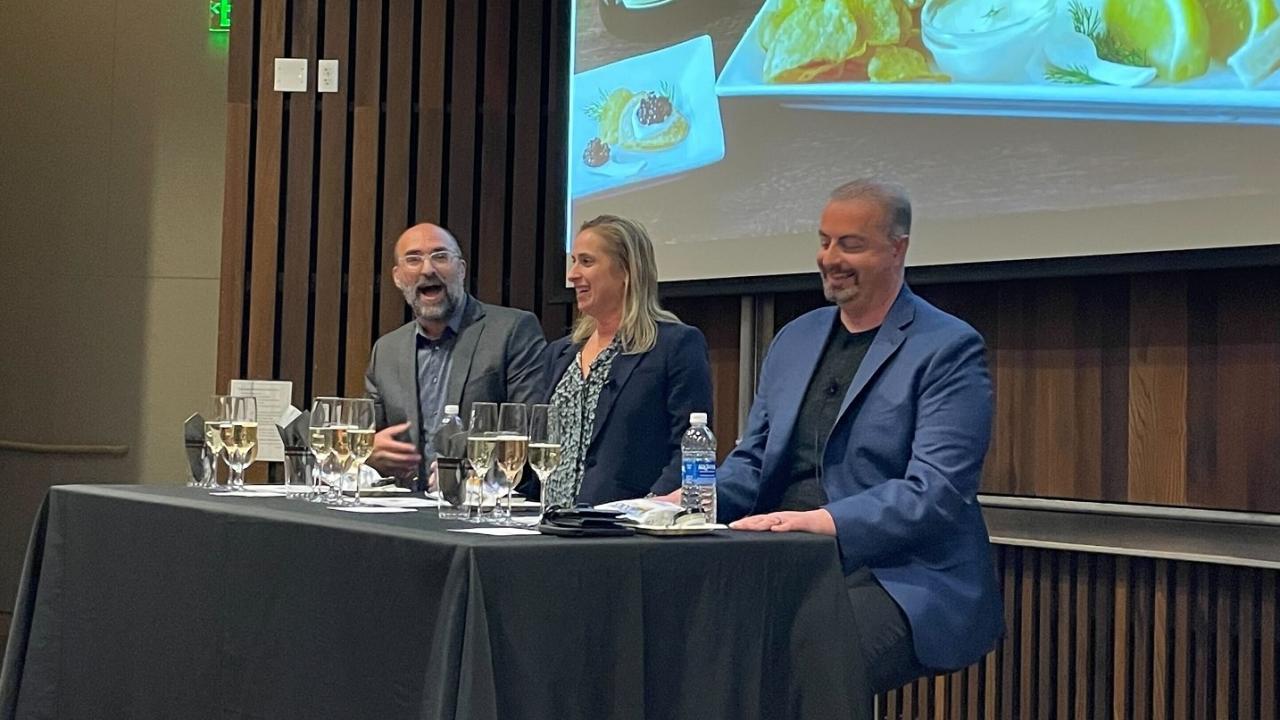
California’s Caviar, Sparkling Wine, and Future of Sustainable Luxuries
Caviar is known as a delicacy worldwide. Although rightfully expensive due to its 6-10 year long production time and very short six-week shelf life, Tsar Nicoulai Caviar is a company willing to turn these tides. Davis community members paired sparkling wines from Domaine Carneros and sturgeon dishes while discovering the close relationship UC Davis has with this unique industry.
Learning From Experts
This exciting Sips and Bites event hosted three specialists, each bringing their perspective to the table. Jackson Gross is a professor at UC Davis with 20 years of experience and focuses on sustainable sturgeon aquaculture and animal welfare. Joining him was Ali Bolourchi, president at Tsar Nicoulai Caviar, and a fellow UC Davis Aggie Alumni who works closely with Dr. Gross on sustainable farming practices.
With great caviar, great wine must be served as well! Enter Remi Cohen, another proud Aggie and the CEO of Domaine Carneros, Napa Valley’s sparkling wine gem. Cohen not only carries forward the estate’s rich tradition of visionary female leadership, but she also leads Domaine Carneros’ unwavering commitment to sustainability.
Let the Tasting Begin
Eager to start, Ali Bolourchi invited attendees to try his personal favorite pairing: Domaine Carneros’s Le Rêve with Tsar Nicoulai Reserve Caviar. Le Rêve is a special sparkling wine made entirely from Chardonnay grapes. It is a Blanc de Blancs Tête de Cuvée, meaning it is made entirely from white grapes and represents “the best of the batch."
Cohen described the wine as “a true expression of Domaine Carneros,” explaining how it was aged with the yeast used during fermentation for six years to develop a luxurious creaminess and depth. Its brightness beautifully lifted the rich, buttery flavors of the caviar. The sparkling wine, with its soft golden hue and fine bubbles, complemented the texture of the dark pearls of the Reserve Caviar. As stated on the tin, the caviar was served in, all caviar produced at Tsar Nicoulai is sustainably farmed in the USA.
The next pairing, a smoked sturgeon paté with the Cuvée de la Pompadour Brut Rosé, was the most unique, in my opinion. The paté was buttery smooth and served as a great dip for the potato chips provided. It was shocking to hear that both the fatty collar of the sturgeon and the dense and flaky tail were combined to make this rich mixture.
This innovative take on using the entire sturgeon is what sustainable farming is all about. The Brut Rosé had delicate notes of wild strawberries and rose petals, with a refreshing tartness that lifted the richness of the paté. Its soft pink color and fine mousse added an elegant touch.
Remi Cohen revealed that their wines are never aged in barrels, emphasizing, “When you have the finest caviar, you don’t need to add eggs and onions. That’s how we feel about our sparkling wine…without the bells and whistles of oak.”
The tasting finished with a slice of a smoked sturgeon and a glass of Domaine Carneros Brut sparkling wine. The meat was dense and sweet, almost like a honey ham on Christmas. Dr. Gross shared that the meat pieces were firm because the sturgeon has cartilage like a shark. The Brut was crisp, with notes of green apple, lemon, and toasted brioche. Its balanced acidity cuts through the smoky, savory flavors of the fish, creating a harmonious pairing.
The Origins of Sturgeon Farming
With 27 global species of sturgeon, eight of which are found in the United States, these living fossils have been the key to caviar industry research. Sturgeon became endangered in the 1950s, which pushed the creation of sturgeon aquaculture, led by Dr. Serge Doroshov.
By the mid-1980s, reliable sturgeon farming had begun, and in 1988, Dr. Fred Conte developed the first hatchery manual for sturgeon. By 1994, the first farmed caviar was produced in California, marking a huge leap in the industry. However, there is still research to ensure the sustainable growth and welfare of these fish.
Changes to Caviar
Dr. Gross advocated for further research in sturgeon diets, reducing the need for antibiotics and improving the endless ultrasounds to determine if a sturgeon is male or female. Over 1 million fish are farmed, and each one must be caught to find out its gender. Currently, research in AI tools for this problem is being tested. UC Davis is focused on improving the well-being of sturgeon, not just in the United States but globally, to ensure a sustainable future for both the fish and the caviar industry.
Sustainable farming is a top priority at Tsar Nicoulai Caviar, but they are ready to push the industry further. Caviar is thought of as an indulgence saved for special occasions, but “80-85% of what we do at our farm is not caviar, it’s sturgeon,” Ali states.
The team has been working on innovative products, such as pepper-smoked sturgeon jerky, which won the Good Food Award in 2024. Another new idea is a gluten-free sturgeon-based chip with tapioca. To increase the shelf life of these fish, the ability to put sturgeon in a tin, just like tuna, has been experimented with as well. As there are so many things to do with sturgeon, it’s great to hear that the heart of every product is sustainability, animal welfare, and U.S.-sourced ingredients.
Both Tsar Nicoulai Caviar and Domaine Carneros have pushed boundaries to balance luxury and responsibility. Through their work, with the help of experts like Dr. Gross, we can look forward to a more sustainable future for these high-quality products. To learn more about these businesses please visit their websites: Domaine Carneros and Tsar Nicoulai Caviar.


Gwen Gonzalez is a fourth-year food science major passionate about storytelling and food innovation. She is an active member of the Food Tech Club on campus and assists in Guinard's Lab pursuing sensory science. When she's not thinking about food, she immerses herself in music and the performing arts at the Manetti Shrem Museum and Mondavi Center for the Performing Arts. In the future, she hopes to merge her interests in food and the arts and contribute to creative research and development in the food industry.
